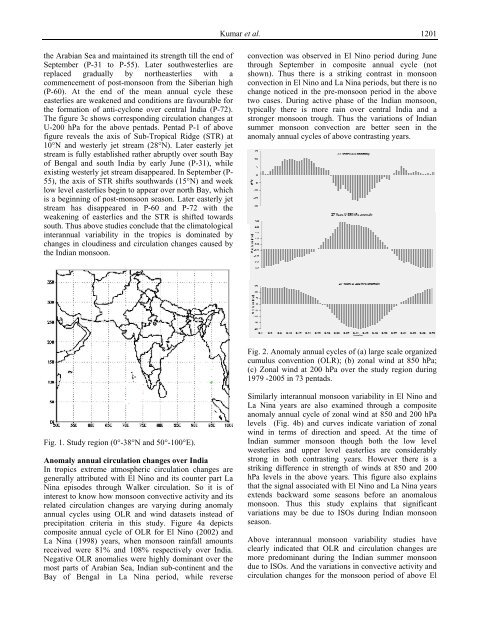Download (5Mb) - Covenant University Repository
Download (5Mb) - Covenant University Repository
Download (5Mb) - Covenant University Repository
You also want an ePaper? Increase the reach of your titles
YUMPU automatically turns print PDFs into web optimized ePapers that Google loves.
the Arabian Sea and maintained its strength till the end of<br />
September (P-31 to P-55). Later southwesterlies are<br />
replaced gradually by northeasterlies with a<br />
commencement of post-monsoon from the Siberian high<br />
(P-60). At the end of the mean annual cycle these<br />
easterlies are weakened and conditions are favourable for<br />
the formation of anti-cyclone over central India (P-72).<br />
The figure 3c shows corresponding circulation changes at<br />
U-200 hPa for the above pentads. Pentad P-1 of above<br />
figure reveals the axis of Sub-Tropical Ridge (STR) at<br />
10°N and westerly jet stream (28°N). Later easterly jet<br />
stream is fully established rather abruptly over south Bay<br />
of Bengal and south India by early June (P-31), while<br />
existing westerly jet stream disappeared. In September (P-<br />
55), the axis of STR shifts southwards (15°N) and week<br />
low level easterlies begin to appear over north Bay, which<br />
is a beginning of post-monsoon season. Later easterly jet<br />
stream has disappeared in P-60 and P-72 with the<br />
weakening of easterlies and the STR is shifted towards<br />
south. Thus above studies conclude that the climatological<br />
interannual variability in the tropics is dominated by<br />
changes in cloudiness and circulation changes caused by<br />
the Indian monsoon.<br />
Fig. 1. Study region (0°-38°N and 50°-100°E).<br />
Anomaly annual circulation changes over India<br />
In tropics extreme atmospheric circulation changes are<br />
generally attributed with El Nino and its counter part La<br />
Nina episodes through Walker circulation. So it is of<br />
interest to know how monsoon convective activity and its<br />
related circulation changes are varying during anomaly<br />
annual cycles using OLR and wind datasets instead of<br />
precipitation criteria in this study. Figure 4a depicts<br />
composite annual cycle of OLR for El Nino (2002) and<br />
La Nina (1998) years, when monsoon rainfall amounts<br />
received were 81% and 108% respectively over India.<br />
Negative OLR anomalies were highly dominant over the<br />
most parts of Arabian Sea, Indian sub-continent and the<br />
Bay of Bengal in La Nina period, while reverse<br />
Kumar et al.<br />
1201<br />
convection was observed in El Nino period during June<br />
through September in composite annual cycle (not<br />
shown). Thus there is a striking contrast in monsoon<br />
convection in El Nino and La Nina periods, but there is no<br />
change noticed in the pre-monsoon period in the above<br />
two cases. During active phase of the Indian monsoon,<br />
typically there is more rain over central India and a<br />
stronger monsoon trough. Thus the variations of Indian<br />
summer monsoon convection are better seen in the<br />
anomaly annual cycles of above contrasting years.<br />
Fig. 2. Anomaly annual cycles of (a) large scale organized<br />
cumulus convention (OLR); (b) zonal wind at 850 hPa;<br />
(c) Zonal wind at 200 hPa over the study region during<br />
1979 -2005 in 73 pentads.<br />
Similarly interannual monsoon variability in El Nino and<br />
La Nina years are also examined through a composite<br />
anomaly annual cycle of zonal wind at 850 and 200 hPa<br />
levels (Fig. 4b) and curves indicate variation of zonal<br />
wind in terms of direction and speed. At the time of<br />
Indian summer monsoon though both the low level<br />
westerlies and upper level easterlies are considerably<br />
strong in both contrasting years. However there is a<br />
striking difference in strength of winds at 850 and 200<br />
hPa levels in the above years. This figure also explains<br />
that the signal associated with El Nino and La Nina years<br />
extends backward some seasons before an anomalous<br />
monsoon. Thus this study explains that significant<br />
variations may be due to ISOs during Indian monsoon<br />
season.<br />
Above interannual monsoon variability studies have<br />
clearly indicated that OLR and circulation changes are<br />
more predominant during the Indian summer monsoon<br />
due to ISOs. And the variations in convective activity and<br />
circulation changes for the monsoon period of above El

















